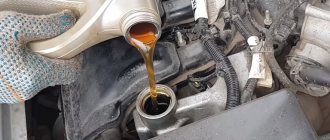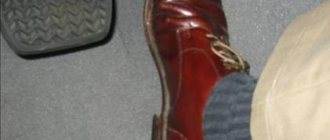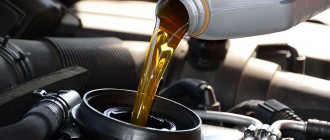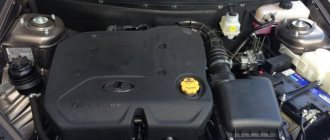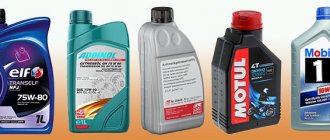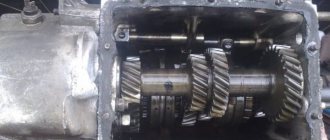06 March 2020 Lada.Online 166 524 72
Oil consumption is provided for by the engine design and cannot be equal to zero, otherwise the engine will be destroyed. At AVTOVAZ there are standards for the consumption of motor oil, and the standards are the same for all VAZ engines (starting from the VAZ 21213 engine, which is installed on the Lada 4×4, ending with modern 1.6 and 1.8 liter VAZ 21126, VAZ-21129, VAZ-21179 engines). Let's figure out how much oil a VAZ engine should consume, as well as which of the AvtoVAZ engines is the most voracious.
How much is normal oil consumption?
Many car manufacturers indicate completely absurd figures for permissible oil consumption in the operating instructions. For example - 1 liter per 1000 km in difficult conditions or per 1500 km during normal use. This is how they try to protect themselves from claims from owners of modern cars (whose engines consume liters of oil) before the end of the warranty period or mileage.
During normal operation, the engine consumes no more than 1 liter per 7000–8000 km. That is, the norm is not to add oil from change to change (we recommend doing it twice as often as most manufacturers require).
Higher consumption is an oil burner that must be dealt with.
Coolant replacement
First of all, you need to drain the old antifreeze through the drain hole in the radiator. In this case, it is necessary to protect the generator from liquid ingress. You can speed up the draining process by removing the lid from the tank.
Attention! If the drained antifreeze is green, then it cannot be used because it has lost its cooling properties.
- Remove the heating pipe for the throttle body.
- Fill the liquid slightly above the level indicated on the reservoir.
- Press the nozzle to pump out the air.
Thus, detecting a leak in a VAZ-2114 is quite simple. You just need to carefully inspect the cooling system. And fixing a leak will not be a problem for an experienced car owner.
Find and repair leaks
The most easily identified cause of excessive oil consumption is a leak. There are many seals in an engine that can become damaged over time. For example, the following may leak:
- crankshaft seals - front and rear oil seals. A rear leak damages the clutch, a front leak damages the timing belt or auxiliary drive belts;
- camshaft seals (again, belts suffer);
- gasket and now common non-gasket (on sealant) connections;
- plug in the oil drain pan or oil filter;
- For supercharged engines, the turbocharger oil supply and drain pipes may leak.
Most often, the problem is solved by replacing gaskets and seals.
Fix it yourself or go to a service station?
Once again I want to draw your attention, this is very important! All work on replacing cooling system elements is carried out exclusively with the engine turned off and the coolant cooled down.
You can replace the pipes, thermostat, radiator filler cap, and expansion tank cap yourself. Remove the filler cap on the radiator. Unscrew the drain plug on the engine and drain the coolant into a clean container.
As for replacing the gasket between the valve head and the piston block, repairing a rotten engine cooling jacket and repairing radiators, these works are best done at specialized stations.
Since such repairs will require the use of specific tools and the necessary experience and knowledge.
Carry out decarbonization
If the cause of the oil burn is coked oil scraper rings, you can try, without disassembling the engine, to clean its parts from deposits using auto chemical products. In the early stages of loss of mobility by rings, it is possible to overcome the problem. Although it is, of course, impossible to guarantee a 100% result.
Of all the variety of decarbonizers, the best results are obtained by preparations that form foam in the cylinder. Due to their high penetrating power, they completely clean the combustion chamber.
Of all the variety of decarbonizers, the best results are obtained by preparations that form foam in the cylinder. Due to their high penetrating power, they completely clean the combustion chamber.
ICE defects
If the coolant level continues to drop due to defects in the cylinder head or the block itself, you will have to contact a service center to replace them. It is also better not to change the gasket yourself, but to entrust it to the experts. But you can easily change the sealing seal yourself. To do this you need:
- buy a gasket of a specific brand so that it matches the engine (according to the VIN code);
- remove the cylinder head cover, freeing it from the attached parts;
- unscrew the mounting bolts and check the operation of the system;
- if the antifreeze continues to disappear, it is worth dismantling the cylinder head, then you can see the location of the defect;
- replace the gasket and put everything back together.
it is important! After any repair work on the cooling system, you should use only new components - pipes, seals, rubber hoses, etc. The installed parts must not have visible defects that could lead to antifreeze leaks. It is equally important to fill the system with high-quality coolant from a reliable and trusted manufacturer.
Replace piston rings
Modern engines have short pistons and thin rings that have low elasticity. Under unfavorable conditions (overheating or infrequent oil changes), they will freeze up very quickly, and increased oil consumption will begin.
Modern engines have short pistons and thin rings that have low elasticity. Under unfavorable conditions (overheating or infrequent oil changes), they will freeze up very quickly, and increased oil consumption will begin.
Some modern engines have a design that allows access to the lower connecting rod caps by removing the oil pan.
Why is lubricant quickly used up?
"Priora", despite its modern engine, "eats" a lot of oil. The reasons for this are as follows:
- the appearance of a leak;
- wear of spare parts;
- low quality motor oil;
- exceeded operating period;
- burning of oil liquid.
Often, car oil leaks occur due to poor crankcase ventilation. This happens because the exhaust enters the crankcase through the piston rings. Gases create increased compression, which disrupts the normal flow of processes in the unit. The oil is simply squeezed out of the engine.
Why do Priors eat oil, besides the reasons listed above? Oil is probably leaking from the valve plug or oil filter. To eliminate such leaks, the lining must be replaced. Constant vibration exposure, high loads, trips over rough terrain - all this causes various leaks.
Oil leaking from under the engine
Synthetics have good viscosity characteristics, ensuring the uninterrupted functioning of all units. It contains many additives that soften and partially eliminate the consequences of the negative impact on the power unit.
Mineral water does not have the advantages of synthetics. It pollutes the lubricating complex with its own combustion products. As a result, it turns out that the car “eats” oil.
An excessive operating period may also be the reason that the machine eats oil. Since the characteristics of the motor oil deteriorate during operation, some of the lubricant evaporates and burns out.
This negatively affects the car engine. Timely measures taken will allow the power unit to operate without failures for a long time.
Repair turbocharger
If you have a turbocharged engine, the rotor seals may be leaking a lot of oil. The pressure in the bushing is equal to the pressure in the engine oil system and greater than the pressure in the turbine and compressor parts. Therefore, oil can penetrate both the intake, contaminating the piston part of the engine, and the exhaust, damaging the catalytic converter.
The defect can be treated by repairing or replacing the cartridge (the middle part along with the turbine and compressor impellers). But more often you have to purchase a new turbocharger.
When the turbocharger wears out, you can only change the middle part - the cartridge with a balanced rotor. The aluminum body (volatile) just needs to be checked for cracks.
When the turbocharger wears out, you can only change the middle part - the cartridge with a balanced rotor. The aluminum body (volatile) just needs to be checked for cracks.
Symptoms of a malfunctioning crankcase ventilation system
- the smell of burnt oil in the car interior when the engine is running;
- increased fuel and oil consumption;
- traces of oil on the body and breather pipe outside or near them;
- smoke from the oil filler neck when unscrewing the cap;
- clogging of carburetor jets, oiling of the air filter housing, throttle body and the insides of the intake manifold;
- squeezing out oil through gaskets, seals, and dipstick hole.
Some car owners, faced with the problem of oil escaping through the breather, disconnect its pipe from the inlet or filter housing and turn it down. This doesn't fix
the root cause of the problem, but only prevents oil from entering the intake, carburetor and throttle valve. In addition, toxic crankcase gases
Partially will end up in the car interior.
What if it doesn't help?
You will have to do a major overhaul, restoring the geometry of the cylinders and replacing the pistons. A “capital” is also necessary if the engine turns out to be worn out when opened. Otherwise, in the future you will pay more money for repeated repairs and liters of oil that will need to be added.
- How to extend the life of the motor is described here.
- Car accessories “Behind the wheel” - the choice of experts!
- A fire extinguisher for a car is not just a requirement of the traffic police, but a guarantee of safety for the driver and his passengers.
8 ways to reduce oil consumption. No engine overhaul
How to determine the cause of oil burn in 5 minutes: 3 simple tests for 2021
If engine oil consumption increases, it is advisable to immediately start looking for the cause. If the power unit “eats” the lubricant with great appetite, then this indicates impending problems. It is important to get ahead of their source in a timely manner and eliminate it. You can carry out diagnostics in just a few minutes. Moreover, such a procedure does not require special skills or abilities.
Causes of leaks
In order to fix the problem, you need to find out why the oil is leaking. The reasons may be different:
- Defective gaskets or seals. There are a lot of them in the engine - in the area of the gas distribution mechanism (GRM), cylinder head (cylinder head), oil filter, crankshaft, as well as other components of the power plant.
- Malfunction of the crankcase ventilation system. While the engine is running, some of the exhaust gases break through the oil scraper and compression rings into the crankcase. They create excess pressure on the engine oil. Thus, the lubricant can be squeezed out through the seals or gaskets, because some of them may not withstand such pressure.
- Poor quality oil fluid. Counterfeit motor fluid is often sold on the market under the guise of original fluid. It is quite difficult to recognize it, so car enthusiasts, especially inexperienced ones, often buy fakes. The operation of the engine leads to an increase in temperature to 250–300°C in the area of the cylinder-piston group. The counterfeit product loses its viscosity and liquefies. In this state, it leaks through the seals in large quantities. The same applies to waste - flowing through the piston rings, such “oil” burns along with the fuel. Fumes are indicated by the bluish color of the exhaust gases escaping from the exhaust pipe.
- Finally, the most common reason is damage to the oil pan during a trip. Sometimes objects come across under the bottom that can seriously damage the pallet. That's why some automakers, as well as many car owners, install additional protection on the crankcase.

